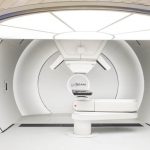Interserve was appointed by The Christie NHS Foundation Trust to design and construct the UK’s first NHS high energy Proton Beam Therapy facility. Work started onsite in 2015 and is due to complete ahead of programme in April 2018.
The construction of the centre is being funded by the Department of Health and will be one of only two high energy NHS proton beam therapy centres, the other being built at University College London Hospitals (UCLH).
Proton beam therapy is a specialist form of radiotherapy which can very precisely target certain cancers, increasing success rates and reducing side-effects. Its introduction to the UK will bring the treatment closer to patients who currently have to travel abroad to unfamiliar surroundings and be separated from their support network during a time of significant personal stress.
This technically challenging project was constructed in a suburban residential area; on a restricted site; and adjoining live hospital buildings at the UK’s busiest cancer hospital treating immunosuppressed patients. Because of its unique nature it has attracted significant interest from NHS England, the Trust and the local business community, putting significant pressure on the team to ensure it is an exemplar project in every regard.
Other challenges faced in the delivery of this project included :
- The lack of UK design and construction expertise
- The scale and complexity: Cyclotron the size of a car weighing 90t; 16,000m3 of concrete placed in over 107 pours, requiring 2667 concrete wagons; Concrete walls up to 6m thick to prevent cracking and radiation leakage; 1620t of reinforcement; and 9.1km of embedded pipework
- Coordinating 3 equipment designs
- A potential three month delay due to late information from the equipment provider
- Delivering multiple, major projects concurrently for the client
- Managing the increased amount of traffic on Oak








